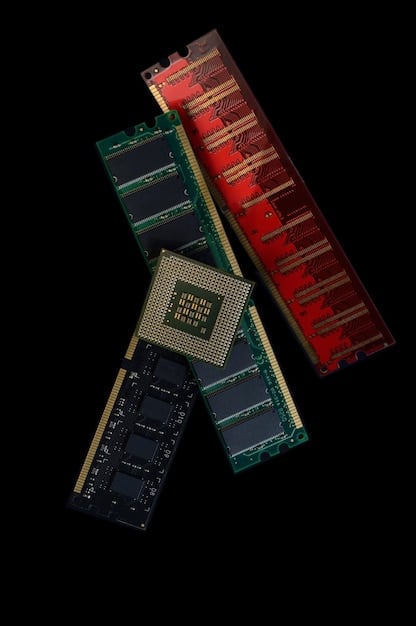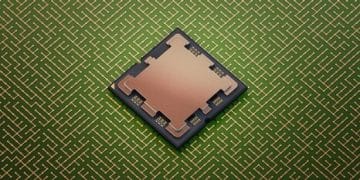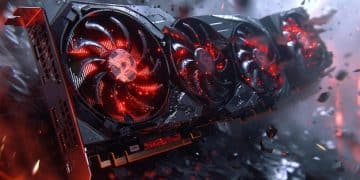AMD AFMF: Up to 60% FPS Boost in Early Benchmarks

AMD Fluid Motion Frames (AFMF) is a frame generation technology that aims to increase perceived FPS in games by creating and inserting frames, potentially boosting performance by up to 60% in select titles, as indicated by early benchmarks.
The world of PC gaming is constantly evolving, with new technologies emerging to push the boundaries of performance and visual fidelity. One such technology making waves is AMD Fluid Motion Frames (AFMF): Early Benchmarks Show Up to 60% FPS Increase in Select Titles, promising smoother gameplay and enhanced experiences for gamers.
Understanding AMD Fluid Motion Frames (AFMF)
AMD Fluid Motion Frames (AFMF) is a frame generation technology designed to enhance the gaming experience by increasing the perceived frame rate. It works by analyzing existing frames within a game and creating new, intermediate frames to insert between them. This results in a smoother, more fluid visual experience, especially in demanding titles where reaching high frame rates can be challenging.
Unlike traditional methods of increasing frame rates, AFMF does not rely solely on raw processing power. Instead, it leverages advanced algorithms and hardware acceleration to generate new frames efficiently. This allows gamers to enjoy higher frame rates without necessarily needing to upgrade their entire system.

How Does AFMF Work?
The core principle behind AFMF is frame interpolation. The technology analyzes two consecutive frames rendered by the game and estimates the motion vectors of objects and elements within the scene. Based on this analysis, it generates a new frame that sits between the original two, effectively doubling the frame rate.
This process happens in real-time and is designed to be as seamless as possible, minimizing any visual artifacts or latency issues. AMD has invested heavily in refining the algorithms that drive AFMF, ensuring that the generated frames are visually consistent with the original content.
Benefits of Using AFMF
There are several key benefits to using AMD Fluid Motion Frames in gaming:
- Increased perceived frame rate: The primary benefit is a smoother and more responsive gaming experience, especially in games that tend to have lower frame rates.
- Improved visual fluidity: By filling in the gaps between frames, AFMF reduces the appearance of stuttering or jerkiness, resulting in a more pleasing visual experience.
- Potential performance boost: In some cases, AFMF can provide a noticeable performance boost without requiring significant hardware upgrades.
- Wider compatibility: AFMF is designed to work with a wide range of games and hardware configurations, making it a more accessible solution for gamers.
In conclusion, AMD Fluid Motion Frames (AFMF) is an innovative technology that aims to enhance the gaming experience by intelligently generating and inserting new frames, leading to smoother gameplay and improved visual quality.
Early Benchmarks and Performance Gains
The true measure of any new gaming technology lies in its performance on real-world benchmarks. Early results for AMD Fluid Motion Frames (AFMF) have been promising, with some titles showing significant gains in frame rates. However, it’s important to note that these are preliminary findings and that performance can vary widely depending on the game, hardware, and settings.
Several tech reviewers and gaming enthusiasts have put AFMF through its paces, testing it on a variety of games and hardware configurations to gauge its impact on performance. The results have been mixed, but generally positive, with some users reporting substantial improvements in frame rates.
Reported FPS Increases
One of the most striking findings from early benchmarks is the potential for significant FPS increases in certain titles. Some users have reported frame rate boosts of up to 60% when using AFMF, which can be a game-changer for demanding games that struggle to maintain playable frame rates.
However, it’s important to take these numbers with a grain of salt. The actual FPS increase will depend on a variety of factors, including the game itself, the hardware being used, and the settings selected. Some games may benefit more from AFMF than others, and some hardware configurations may be better suited to the technology.
Potential Drawbacks and Limitations
While the potential performance gains of AFMF are impressive, it’s important to be aware of potential drawbacks and limitations. One common issue is input lag, which can occur when the generated frames introduce a delay between the player’s actions and the on-screen response.
- Input Lag: The process of generating new frames can introduce a slight delay, which may be noticeable in fast-paced games where responsiveness is critical.
- Visual Artifacts: In some cases, the generated frames may not be perfectly consistent with the original content, leading to visual artifacts or distortions.
- Compatibility Issues: AFMF may not work well with all games, and some titles may experience compatibility issues or performance degradation.
Overall, early benchmarks for AMD Fluid Motion Frames suggest that it has the potential to provide significant performance gains in certain scenarios. However, it’s important to be aware of the potential drawbacks and limitations and to test the technology thoroughly before relying on it for optimal gaming performance.
Hardware and Software Requirements
Before diving into AMD Fluid Motion Frames (AFMF), it’s crucial to understand the hardware and software prerequisites for the technology to function correctly. AFMF is not universally compatible and requires specific AMD hardware and software configurations to operate.
To ensure a smooth experience, users need to verify that their systems meet the minimum requirements. This includes the graphics card, processor, and software drivers. Failure to meet these requirements may result in AFMF not functioning, or worse, causing instability in the system.

Compatible AMD GPUs
Currently, AMD Fluid Motion Frames primarily supports newer generations of AMD Radeon GPUs. These GPUs have the necessary hardware capabilities to handle the frame generation process efficiently. Older GPUs may not be supported due to architectural limitations.
Some of the supported GPUs include:
- AMD Radeon RX 7000 Series
- AMD Radeon RX 6000 Series
- Certain AMD Radeon RX 5000 Series (check compatibility lists)
Software and Driver Requirements
In addition to compatible hardware, specific software and driver versions are necessary for AFMF to function. AMD typically releases updated Adrenalin software suites that include support for new features like AFMF. Users need to ensure they have the latest drivers installed.
Key software requirements include:
- AMD Adrenalin Software (latest version recommended)
- Windows 10 or Windows 11 (64-bit versions)
- DirectX 12 support
In summary, meeting the hardware and software requirements is essential for utilizing AMD Fluid Motion Frames. Users should ensure their systems are up to date and compatible to leverage the benefits of this technology.
Comparing AFMF with Other Frame Generation Technologies
AMD Fluid Motion Frames (AFMF) is not the only frame generation technology available in the market. Other companies, such as Nvidia with its DLSS Frame Generation, have also developed similar technologies to enhance gaming performance. Understanding the differences between these technologies is essential for making informed decisions.
Each technology has its unique approach to frame generation and offers specific advantages and disadvantages. By comparing AFMF with its competitors, gamers can better assess which solution best fits their needs and hardware configurations.
AMD AFMF vs. Nvidia DLSS Frame Generation
The most prominent competitor to AFMF is Nvidia’s DLSS Frame Generation. While both technologies aim to increase frame rates, they employ different techniques and have distinct hardware requirements.
Key differences include:
- Hardware Dependency: DLSS Frame Generation relies on Nvidia’s Tensor Cores, which are exclusive to RTX series GPUs. AFMF, on the other hand, aims to be more broadly compatible with AMD’s newer GPUs.
- Algorithm Approach: DLSS uses deep learning to generate frames, leveraging AI models trained on high-quality images. AFMF uses a more traditional frame interpolation method.
- Image Quality: DLSS often provides better image quality due to its AI-driven approach, which can reconstruct finer details. AFMF may sometimes produce visual artifacts.
Other Frame Generation Solutions
Besides AFMF and DLSS, other frame generation solutions exist, although they may not be as widely adopted. These technologies often use variations of frame interpolation and may be integrated into specific game engines or software.
Examples include:
- Game-Specific Implementations: Some game developers implement their own frame generation techniques tailored to their specific titles.
- Third-Party Software Solutions: Certain software tools offer frame interpolation features that can be applied to games, but these are often less optimized.
In conclusion, while AMD Fluid Motion Frames aims to provide a more accessible solution for a wider range of AMD GPUs, Nvidia DLSS Frame Generation often delivers superior image quality due to its AI-driven approach. The best choice depends on individual hardware and gaming preferences.
Optimizing Game Settings for AFMF
To maximize the benefits of AMD Fluid Motion Frames (AFMF), it’s essential to optimize game settings appropriately. AFMF works best when the initial frame rate is reasonably stable, so tweaking graphics settings to achieve a good balance between visual quality and performance is crucial.
Different games have different performance profiles, and what works well in one title may not be optimal in another. Experimenting with various settings and monitoring performance metrics can help users fine-tune their gaming experience with AFMF.
Adjusting Graphics Settings
Lowering certain graphics settings can help increase the base frame rate, allowing AFMF to generate smoother interpolated frames. Key settings to consider adjusting include:
- Resolution: Reducing the resolution can significantly improve performance, especially on high-resolution displays.
- Shadow Quality: Shadows are often performance-intensive, so lowering shadow quality can free up resources.
- Texture Quality: High-resolution textures can strain VRAM, so reducing texture quality can improve performance.
- Anti-Aliasing: While anti-aliasing improves image smoothness, it can also impact performance. Try different anti-aliasing methods or reduce the level.
Monitoring Performance Metrics
Monitoring performance metrics such as frame rate, GPU usage, and temperatures can provide valuable insights into how AFMF is performing and whether adjustments are needed. Tools like AMD Adrenalin’s performance overlay can help track these metrics.
Key metrics to monitor include:
- Frame Rate (FPS): Track the average and minimum frame rates to assess overall performance.
- GPU Usage: Monitor GPU utilization to ensure the graphics card is not being bottlenecked.
- GPU Temperature: Keep an eye on GPU temperatures to prevent overheating, which can lead to performance throttling.
By carefully optimizing game settings and monitoring performance metrics, users can ensure that AMD Fluid Motion Frames provides the best possible gaming experience. Experimentation and fine-tuning are key to achieving optimal results.
The Future of Frame Generation Technologies
Frame generation technologies like AMD Fluid Motion Frames (AFMF) are poised to play an increasingly important role in the future of gaming. As games become more visually demanding and hardware struggles to keep pace, these technologies offer a way to enhance performance without requiring costly upgrades.
The development and refinement of frame generation technologies are ongoing, with companies continually seeking new ways to improve image quality, reduce latency, and broaden compatibility. The future holds exciting possibilities for these technologies and their impact on the gaming landscape.
Advancements in Algorithms and AI
Future frame generation technologies are likely to leverage more advanced algorithms and artificial intelligence to produce even better results. AI-driven techniques, like those used in Nvidia’s DLSS, have the potential to reconstruct finer details and reduce visual artifacts.
Areas of advancement include:
- Improved Motion Estimation: More accurate motion estimation algorithms will result in smoother and more realistic interpolated frames.
- AI-Driven Reconstruction: AI models trained on vast datasets of high-quality images can fill in missing details and improve overall image quality.
- Real-Time Optimization: Dynamic optimization techniques can adapt to changing game scenes and adjust frame generation parameters on the fly.
Integration with Game Engines
Closer integration with game engines will also be a key factor in the future of frame generation technologies. By working directly with game developers, companies can optimize their technologies for specific titles and ensure seamless compatibility.
- Native Support: Game engines may begin to include native support for frame generation technologies, making it easier for developers to implement them.
- Customized Solutions: Tailored frame generation solutions can be developed for specific games, taking into account their unique characteristics and performance profiles.
- Enhanced Visual Fidelity: Direct integration with game engines can enable more advanced frame generation techniques that improve visual fidelity and reduce artifacts.
In conclusion, AMD Fluid Motion Frames and similar technologies represent a significant step forward in gaming performance enhancement. Continuous advancements in algorithms, AI, and game engine integration promise an even brighter future for frame generation technologies.
| Key Point | Brief Description |
|---|---|
| 🚀 FPS Boost | Up to 60% FPS increase in select titles with AFMF enabled. |
| ⚙️ Compatibility | Requires specific AMD GPUs and Adrenalin software. |
| 🆚 DLSS | Compares with Nvidia DLSS Frame Generation, each with pros and cons. |
| 🎮 Game Settings | Optimizing game settings is crucial for maximizing AFMF benefits. |
[FAQ about AMD Fluid Motion Frames (AFMF)]
▼
AMD Fluid Motion Frames (AFMF) is a frame generation technology designed to increase perceived FPS in games by creating intermediate frames, aiming for smoother gameplay.
▼
AFMF primarily supports newer AMD Radeon GPUs like the RX 7000 and RX 6000 series. Check AMD’s official documentation for a complete, updated list.
▼
AFMF aims for broader AMD GPU compatibility, while DLSS Frame Generation uses AI on RTX GPUs for potentially better image quality.
▼
You’ll need the latest AMD Adrenalin software, Windows 10 or 11 (64-bit), and DirectX 12 support to run AFMF effectively.
▼
Lowering resolution, shadow quality, and texture quality can help increase base FPS, maximizing the benefits of AMD Fluid Motion Frames (AFMF).
Conclusion
In conclusion, AMD Fluid Motion Frames (AFMF) presents an intriguing approach to enhancing gaming performance by boosting frame rates in select titles. Early benchmarks suggest performance gains, but as with any new technology, results may vary. As AFMF continues to evolve, it holds promise for gamers seeking smoother experiences without necessarily upgrading hardware.





